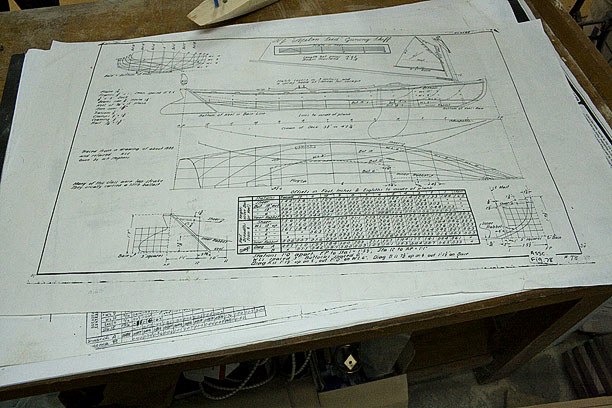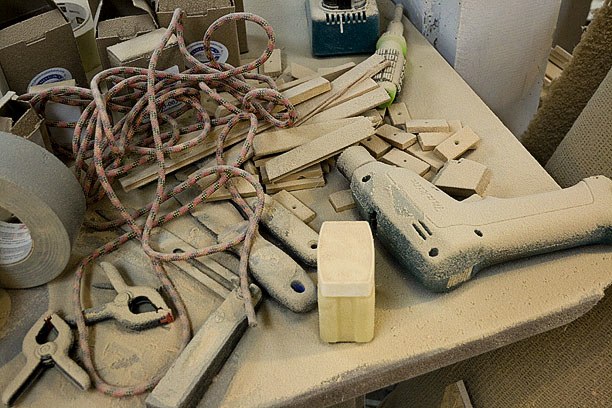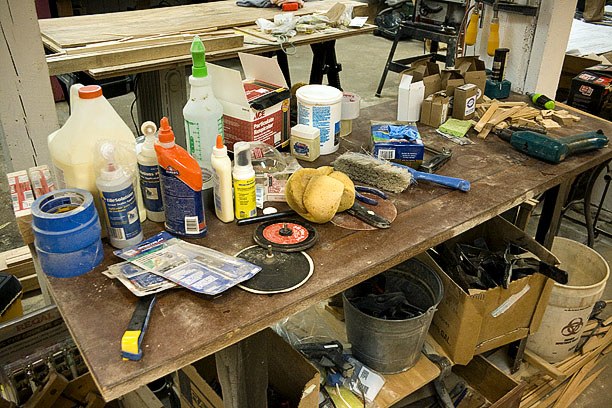I would love to have two sets of those beautiful Shaw & Tenney spoonblade oars. They are truly works of art. But the Boat Budget is getting shallow, and I can see bottom now in places, so I’ve had to make some choices. There are sail kits available from Sailrite, which are pretty reasonable, and they actually have a couple of choices for Melonseed sails. I could have saved some money by making the sails from kits rather than having them made professionally. But I can make serviceable oars more easily than I can make professional quality sails, and the sails will affect the ultimate performance of these boats far more than the oars, so I’ll make the oars. There are some hardware fittings I’ll probably make, too, which will save quite a bit as well. That should see me through to the end.
The Big Box store had a rack of lumber mislabeled as Yellow PIne but was actually premium Eastern White Pine, which is far more lightweight and also harder to find. Jim Michalak has some plans online for making oars, each one from a single 1×6, so I picked four nice planks and brought them home.
I made a set of oars for my first boat, but they were crude and heavy, and frankly ugly. I wanted to do a little better this time. Did various drawings for blade shapes, and decided on something thin and more elegant. Also, there was enough thickness in the planks to work a little spoon-ish shape into them.
Did the basic layout, much like the masts, where the center layer is cut to the exact profile, then laminated on outer layers to build up the required thickness. In this case, the blades were left a little oversize and rough, since the White PIne is so easy to work, and I hadn’t decided on the exact shape yet.
When the glue cured, the initial rounding and wood removal of the looms was done on the table saw, then the block plane, followed by the rolling-pin sander. For the blades, a combination of block plane and power grinder worked in the contours and the hollows. Then used the table saw again to rough out the handles, followed by the belt sander again. In two days they were ready for fine sanding.
 Slightly spooned blades, ready for fine sanding.
Slightly spooned blades, ready for fine sanding.
They turned out pretty well. Not perfect, but much better than last time. These are made for pleasure rowing, not fighting out through a rough surf. Still, I have some thin 3oz fiberglass cloth, and may use it to reinforce the blades and lower looms. Though it will add to the weight, right now they weigh almost nothing.
Took all day, but it’s nice to have everything back in order again. Will make things much more pleasant as this project moves on to the final phases – finishing up interior details, then varnish inside, then the decks go on. After that trim, rudders, then paint and varnish, and final fitting out.
Getting close!
melonseed skiff, mellonseed skiff, melon seed, mellon seed












I continue to follow your progress with great interest. It wonderful to see your craftsmanship and read of your progress. Thank you.
Sunday, April 25, 2010 – 10:26 PM
Good to hear from you again, Bob, thanks. Won’t be long now.
Sunday, May 2, 2010 – 01:45 AM
I’ve enjoyed reading your Melonseed build so much that I’ve decided that the next boat I build will be a Melonseed (I’m a self-confessed serial builder).
What glue did you use for your oar and mast?
dave boling
Hi Dave, congrats. I used the same MAS two part epoxy, thickened with wood flour, that I used elsewhere in the boats, since it’s waterproof and strong. Once the varnish coat gets chipped or scratched I didn’t want the glue to fail before I caught it. The only place I used carpenter’s glue was in the stripping stage. In that case, the glue just holds temporarily until the whole thing gets glassed and sealed in epoxy.
I have a few antique parts to a turn of the century Spritsail Skiff used for fishing off Hatteras. I would like a nice engineering drawing of the skiff but have been unable to find one to display with the artifacts. Any ideas where I can find a drawing?
Thanks in advance–Bob
Hi Bob, sorry I missed this earlier. The best source I can recommend is the Small Craft Collection Archives at the Smithsonian. They are woefully understaffed, and almost impossible to get a hold of, but they have plans on file for a huge assortment of American sailing craft from the mid 1800’s to the early 1900’s. You may have to order the catalog first, just to find out if they have Spritsail Skiffs and what to ask for.
http://americanhistory.si.edu/csr/shipplan.htm
You might also try all the books by Howard Chapelle, who led the creation of the collection. One of his books may contain a drawing detailed enough to copy and enlarge.